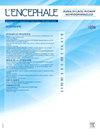痴呆症患者的强迫症状:系统回顾与荟萃分析。
IF 1.2
4区 医学
Q4 NEUROSCIENCES
Encephale-Revue De Psychiatrie Clinique Biologique et Therapeutique
Pub Date : 2024-09-06
DOI:10.1016/j.encep.2024.06.001
引用次数: 0
摘要
痴呆症是一种高发的综合征,其病因多种多样,以一个或多个领域的认知缺陷为特征,功能严重受损,常伴有神经精神症状,其中可能包括强迫症状:这项荟萃分析的主要目的是描述和确定痴呆症患者强迫症状的患病率:为此,研究人员检索了MEDLINE、CENTRAL和Psycnet数据库中从开始到2023年3月的数据。采用了乔安娜-布里格斯研究所(Joanna Briggs Institute)的流行率数据报告研究批判性评估核对表。主要汇总指标为痴呆症患者强迫症状的平均患病率以及每种强迫症状的数量:在筛选出的 643 篇文章中,有 92 篇接受了全文评估。结果:在筛选出的 643 篇文章中,有 92 篇接受了全文评估,其中 30 篇包含了痴呆症患者强迫症状的患病率或任何相关描述,共纳入了 37 个队列(5 项研究包含两个队列,1 项研究包含三个队列)。根据我们的研究结果,强迫症状在痴呆症(35.3%,23.1-47.6%),即额颞叶痴呆症(48.4%,29.8-67.0%)中的发病率相当高;强迫症状在其他痴呆症诊断中的发病率较低(17.6%,9.1-26.2%)。更常见的强迫内容是对称性(28.6%)和躯体性(20.0%);更常见的强迫症状是检查(27.4%);囤积也是一个相关症状(27.8%):讨论:强迫症状在额颞叶痴呆症中的患病率存在相当大的异质性,这在一定程度上与痴呆症的诊断标准以及强迫症状的评估有关。仔细区分强迫症状和类似强迫症状至关重要。对躯体症状的过度警惕、对疾病和死亡的担忧以及注意力和记忆力等认知领域的缺陷可能解释了为什么躯体强迫和检查强迫更为普遍:本研究结果表明,强迫症状可能在许多痴呆症患者的临床过程中普遍存在,尤其是额颞叶痴呆症患者。我们需要更好的工具,以可靠和可比较的方式描述强迫症现象,尤其是在痴呆症患者这类主观性难以获得的人群中。本文章由计算机程序翻译,如有差异,请以英文原文为准。
Obsessive-compulsive symptoms in dementia: Systematic review with meta-analysis
Dementia is a highly prevalent syndrome with various causes, characterized by cognitive deficit in one or more domains, with important impairment of functioning, which frequently presents with neuropsychiatric symptoms that may include obsessive-compulsive symptoms.
Objectives
The main goal of this meta-analysis was to describe and determine the prevalence of obsessive-compulsive symptoms in dementia.
Materials and methods
To accomplish that, MEDLINE, CENTRAL and Psycnet databases were searched from inception to March 2023. The Joanna Briggs Institute Critical Appraisal Checklist for Studies Reporting Prevalence Data was applied. The principal summary measures were the mean of prevalence of obsessive-compulsive symptoms in patients with dementia and the number of each type of obsession or compulsion.
Results
Of the 643 articles screened, 92 were accepted for full-text assessment. Of these, 30 with information on prevalence of obsessive-compulsive symptoms in dementia or any description of those were included, yielding a total of 37 cohorts (5 studies with two cohorts and 1 study with three cohorts). According to our results, obsessive-compulsive symptoms have considerable prevalence in dementia (35.3%, 23.1–47.6%), namely in frontotemporal dementia (48.4%, 29.8–67.0%); obsessive-compulsive symptoms were less frequent in other dementia diagnosis (17.6%, 9.1–26.2%). The more frequent obsessive contents are symmetry (28.6%) and somatic (20.0%); and the more frequent compulsions are checking (27.4%); hoarding is also a relevant symptom (27.8%).
Discussion
There was considerable heterogeneity in the prevalence of obsessive-compulsive symptoms in frontotemporal dementia, that is, in part related with diagnostic criteria for dementia, as well as obsessive-compulsive symptom assessment. A careful distinction between compulsions and compulsive-like symptoms is fundamental. Hypervigilance for somatic symptoms and concerns about disease and mortality, as well as deficits in cognitive domains like attention and memory may explain why somatic obsessions and checking compulsions are more prevalent.
Conclusions
The present results indicate that obsessive-compulsive symptoms may be prevalent in the clinical course of many patients with dementia, especially frontotemporal dementia. Better instruments are needed to describe obsessive-compulsive phenomena in a reliable and comparable way, particularly in a population such as dementia patients, whose subjectivity is difficult to access.
求助全文
通过发布文献求助,成功后即可免费获取论文全文。
去求助
来源期刊
CiteScore
4.60
自引率
7.40%
发文量
162
审稿时长
6-12 weeks
期刊介绍:
Une revue française de renommée internationale.
- Un comite de rédaction représentant tous les aspects de la prise en charge psychiatrique du patient.
- Une sélection rigoureuse d''articles faisant l''objet de plusieurs expertises.
- Des travaux d''auteurs et de chercheurs de renommée internationale.
- Des indexations dans les grandes bases de données (Current Contents, Excerpta Medica, etc.).
- Un facteur d''impact qui témoigne de la grande notoriété de la revue.
La tribune des publications originales de haut niveau.
- Une très grande diversité des sujets traités, rigoureusement sélectionnés à travers des sommaires dynamiques :
- des éditoriaux de médecins référents,
- une revue de presse sur les actualités internationales,
- des articles originaux pour approfondir vos connaissances,
- des mises au point et des cas cliniques pour engager votre réflexion sur les indications et choix possibles au travers de mises en situation clinique,
- des dossiers thématiques pour faire le tour d''une question.
- L''actualité de l''AFPB : L''Encéphale publie régulièrement des comptes rendus de l''Association française de psychiatrie clinique.

 求助内容:
求助内容: 应助结果提醒方式:
应助结果提醒方式:


